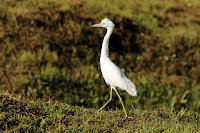LITTLE BLUE HERON
LITTLE BLUE HERON (Egretta caerulea) – (See images below)
DESCRIPTION: The Little Blue Heron has a blue body with a darker blue-purple head and neck. Long and pointed bill is light blue-grey with a dark tip. Eyes are dark yellow. Legs and feet are dark grey. Sexes are similar. Juveniles are white. Bird length is about 60 cm (24 inches).
VOICE: https://www.xeno-canto.org/species/Egretta-caerulea
NAME: ‘Heron’ has a complicated origin and evolved from an ancient Greek word meaning ‘to creak or screech’ (in reference to that bird’s call). Latin genus name ‘Egretta’ stems from French ‘aigrette’. Latin species name ‘caerulea’ means ‘blue’.
HABITAT: Wetlands such as marshes, ponds, rice paddies, along coastal shores.
DIET: Fish, crustaceans, small reptiles, insects.
NESTING: Breeds in colonies in trees or shrubs near or above water. Between three and five light green-blue eggs are laid, incubated by both parents. Chicks fed by both parents.
DISTRIBUTION: Breeds in southeast USA, year-round resident in the coastal areas of southeast USA, the Caribbean, Central America, and northern half of South America. Reported as a vagrant on Hawaii (see note below on bird vagrancy).
DISTRIBUTION MAP: https://en.wikipedia.org/wiki/Little_blue_heron#/media/File:Egretta_caerulea_map.svg
ON PEI: Does not breed on Prince Edward Island, sightings occasional except winter.
CONSERVATION: Population declined over last few decades. Threats include habitat loss and shooting (both legal and illegal) around fish hatcheries, pesticide poisoning from eating contaminated prey. However globally the species is still currently not considered at risk.
Vagrancy: In biology this means an animal going way outside its normal range. For birds, this can happen when there are storms and they get blown off course. On other times, the bird simply wanders in a different direction than usual. Here’s an article about vagrancy in birds.
SIMILAR SPECIES: Snowy Egret (with little blue heron juvenile), Tricolored Heron
REFERENCES: https://guides.nynhp.org/little-blue-heron/ (New York Natural Heritage Program)
http://fieldguide.mt.gov/speciesDetail.aspx?elcode=ABNGA06040 (Montana Field Guide)
https://animaldiversity.org/accounts/Egretta_caerulea/ (University of Michigan)
https://en.wikipedia.org/wiki/Little_blue_heron
https://www.allaboutbirds.org/guide/Little_Blue_Heron/id
https://txtbba.tamu.edu/species-accounts/little-blue-heron/ (Texas Breeding Bird Atlas)
https://birdatlas.mb.ca/accounts/speciesaccount.jsp?sp=LBHE&lang=en (Manitoba Breeding Bird Atlas)
https://www.audubon.org/field-guide/bird/little-blue-heron
https://identify.whatbird.com/obj/46/overview/Little_Blue_Heron.aspx
http://www.nhptv.org/natureworks/littleblueheron.htm (New Hampshire PBS)
DESCRIPTION: The Little Blue Heron has a blue body with a darker blue-purple head and neck. Long and pointed bill is light blue-grey with a dark tip. Eyes are dark yellow. Legs and feet are dark grey. Sexes are similar. Juveniles are white. Bird length is about 60 cm (24 inches).
VOICE: https://www.xeno-canto.org/species/Egretta-caerulea
NAME: ‘Heron’ has a complicated origin and evolved from an ancient Greek word meaning ‘to creak or screech’ (in reference to that bird’s call). Latin genus name ‘Egretta’ stems from French ‘aigrette’. Latin species name ‘caerulea’ means ‘blue’.
HABITAT: Wetlands such as marshes, ponds, rice paddies, along coastal shores.
DIET: Fish, crustaceans, small reptiles, insects.
NESTING: Breeds in colonies in trees or shrubs near or above water. Between three and five light green-blue eggs are laid, incubated by both parents. Chicks fed by both parents.
DISTRIBUTION: Breeds in southeast USA, year-round resident in the coastal areas of southeast USA, the Caribbean, Central America, and northern half of South America. Reported as a vagrant on Hawaii (see note below on bird vagrancy).
DISTRIBUTION MAP: https://en.wikipedia.org/wiki/Little_blue_heron#/media/File:Egretta_caerulea_map.svg
ON PEI: Does not breed on Prince Edward Island, sightings occasional except winter.
CONSERVATION: Population declined over last few decades. Threats include habitat loss and shooting (both legal and illegal) around fish hatcheries, pesticide poisoning from eating contaminated prey. However globally the species is still currently not considered at risk.
Vagrancy: In biology this means an animal going way outside its normal range. For birds, this can happen when there are storms and they get blown off course. On other times, the bird simply wanders in a different direction than usual. Here’s an article about vagrancy in birds.
SIMILAR SPECIES: Snowy Egret (with little blue heron juvenile), Tricolored Heron
REFERENCES: https://guides.nynhp.org/little-blue-heron/ (New York Natural Heritage Program)
http://fieldguide.mt.gov/speciesDetail.aspx?elcode=ABNGA06040 (Montana Field Guide)
https://animaldiversity.org/accounts/Egretta_caerulea/ (University of Michigan)
https://en.wikipedia.org/wiki/Little_blue_heron
https://www.allaboutbirds.org/guide/Little_Blue_Heron/id
https://txtbba.tamu.edu/species-accounts/little-blue-heron/ (Texas Breeding Bird Atlas)
https://birdatlas.mb.ca/accounts/speciesaccount.jsp?sp=LBHE&lang=en (Manitoba Breeding Bird Atlas)
https://www.audubon.org/field-guide/bird/little-blue-heron
https://identify.whatbird.com/obj/46/overview/Little_Blue_Heron.aspx
http://www.nhptv.org/natureworks/littleblueheron.htm (New Hampshire PBS)
 |
| Little blue heron, Brazil, by Dario Sanches |
 |
| Little blue heron juvenile, Charles J. Sharp |